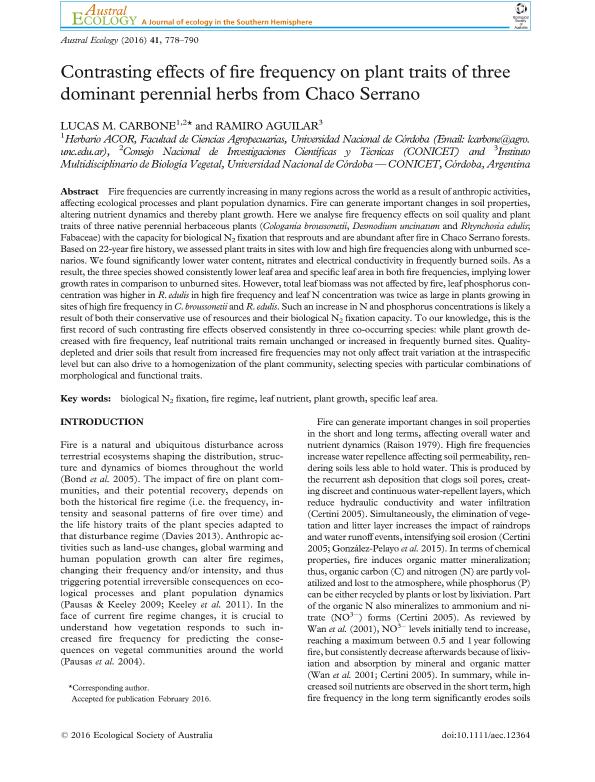Mostrar el registro sencillo del ítem
dc.contributor.author
Carbone, Lucas Manuel

dc.contributor.author
Aguilar, Ramiro
dc.date.available
2017-08-17T19:45:36Z
dc.date.issued
2016-02
dc.identifier.citation
Carbone, Lucas Manuel; Aguilar, Ramiro; Contrasting effects of fire frequency on plant traits of three dominant perennial herbs from Chaco Serrano; Wiley Blackwell Publishing, Inc; Austral Ecology; 41; 7; 2-2016; 778-790
dc.identifier.issn
1442-9985
dc.identifier.uri
http://hdl.handle.net/11336/22610
dc.description.abstract
Fire frequencies are currently increasing inmany regions across the world as a result of anthropic activities, affecting ecological processes and plant population dynamics. Fire can generate important changes in soil properties, altering nutrient dynamics and thereby plant growth. Here we analyse fire frequency effects on soil quality and plant traits of three native perennial herbaceous plants (Cologania broussonetii, Desmodium uncinatum and Rhynchosia edulis; Fabaceae) with the capacity for biologicalN2 fixation that resprouts and is abundant after fire in Chaco Serrano forests. Based on 22-year fire history, we assessed plant traits in sites with low and high fire frequencies along with unburned scenarios. We found significantly lower water content, nitrates and electrical conductivity in frequently burned soils. As a result, the three species showed consistently lower leaf area and specific leaf area in both fire frequencies, implying lower growth rates in comparison to unburned sites. However, total leaf biomass was not affected by fire, leaf phosphorus concentration was higher in R. edulis in high fire frequency and leaf N concentration was twice as large in plants growing in sites of high fire frequency in C. broussonetii and R. edulis. Such an increase in N and phosphorus concentrations is likely a result of both their conservative use of resources and their biologicalN2 fixation capacity. To our knowledge, this is the first record of such contrasting fire effects observed consistently in three co-occurring species: while plant growth decreased with fire frequency, leaf nutritional traits remain unchanged or increased in frequently burned sites. Quality-depleted and drier soils that result fromincreased fire frequenciesmay not only affect trait variation at the intraspecific level but can also drive to a homogenization of the plant community, selecting species with particular combinations of morphological and functional traits.
dc.format
application/pdf
dc.language.iso
eng
dc.publisher
Wiley Blackwell Publishing, Inc

dc.rights
info:eu-repo/semantics/openAccess
dc.rights.uri
https://creativecommons.org/licenses/by-nc-sa/2.5/ar/
dc.subject
Biological N2 Fixation
dc.subject
Fire Regime
dc.subject
Leaf Nutrient
dc.subject
Plant Growth
dc.subject.classification
Bioquímica y Biología Molecular

dc.subject.classification
Ciencias Biológicas

dc.subject.classification
CIENCIAS NATURALES Y EXACTAS

dc.title
Contrasting effects of fire frequency on plant traits of three dominant perennial herbs from Chaco Serrano
dc.type
info:eu-repo/semantics/article
dc.type
info:ar-repo/semantics/artículo
dc.type
info:eu-repo/semantics/publishedVersion
dc.date.updated
2017-08-11T15:11:27Z
dc.identifier.eissn
1442-9993
dc.journal.volume
41
dc.journal.number
7
dc.journal.pagination
778-790
dc.journal.pais
Reino Unido

dc.journal.ciudad
Londres
dc.description.fil
Fil: Carbone, Lucas Manuel. Universidad Nacional de Córdoba. Facultad de Ciencias Agropecuarias; Argentina. Consejo Nacional de Investigaciones Científicas y Técnicas; Argentina
dc.description.fil
Fil: Aguilar, Ramiro. Consejo Nacional de Investigaciones Científicas y Técnicas. Centro Científico Tecnológico Conicet - Córdoba. Instituto Multidisciplinario de Biología Vegetal. Universidad Nacional de Córdoba. Facultad de Ciencias Exactas Físicas y Naturales. Instituto Multidisciplinario de Biología Vegetal; Argentina
dc.journal.title
Austral Ecology

dc.relation.alternativeid
info:eu-repo/semantics/altIdentifier/url/http://onlinelibrary.wiley.com/doi/10.1111/aec.12364/abstract
dc.relation.alternativeid
info:eu-repo/semantics/altIdentifier/doi/http://dx.doi.org/10.1111/aec.12364
Archivos asociados
